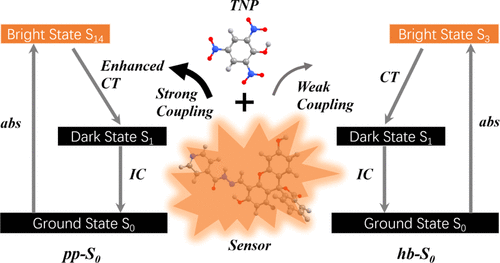当前位置:
X-MOL 学术
›
J. Phys. Chem. A
›
论文详情
Our official English website, www.x-mol.net, welcomes your
feedback! (Note: you will need to create a separate account there.)
Role of the Weak Interactions during the 2,4,6-Trinitrophenol Detecting Process of a Fluorescein-Based Sensor
The Journal of Physical Chemistry A ( IF 2.7 ) Pub Date : 2021-09-02 , DOI: 10.1021/acs.jpca.1c05600 Lei Liu 1, 2 , Bingqing Sun 3 , Ran Ding 3 , Yueyuan Mao 3
The Journal of Physical Chemistry A ( IF 2.7 ) Pub Date : 2021-09-02 , DOI: 10.1021/acs.jpca.1c05600 Lei Liu 1, 2 , Bingqing Sun 3 , Ran Ding 3 , Yueyuan Mao 3
Affiliation

|
Achieving fast and precise fluorescence sensing of 2,4,6-trinitrophenol (TNP) is of fundamental importance for homeland security and environment protection. Weak interactions between the sensor and an analyte always play a critical role, which is capable of affecting the photophysics of the sensor. This study performs a thorough investigation on the effects of the weak interaction between TNP and a typical fluorescein-based sensor. The photophysics of the sensor before and after interacting with TNP is fully discussed by analyzing the potential energy surface (PES) of the sensor and rate constants of the excited-state dynamic processes. TNP is found to affect the PES greatly, which plants an intermolecular electron transfer state (dark state) below the bright state. The π–π interaction is proved to induce considerable orbital overlaps between the analyte and the sensor, which facilitates the electron transfer process and generates the dark state.
中文翻译:

弱相互作用在荧光素传感器检测 2,4,6-三硝基苯酚过程中的作用
实现 2,4,6-三硝基苯酚 (TNP) 的快速、精确荧光传感对于国土安全和环境保护至关重要。传感器和分析物之间的弱相互作用总是起着关键作用,它能够影响传感器的光物理。本研究对 TNP 与典型的基于荧光素的传感器之间的弱相互作用的影响进行了彻底调查。通过分析传感器的势能面(PES)和激发态动力学过程的速率常数,充分讨论了传感器与 TNP 相互作用前后的光物理。发现 TNP 对 PES 影响很大,它在亮态以下植入了分子间电子转移状态(暗态)。
更新日期:2021-09-16
中文翻译:

弱相互作用在荧光素传感器检测 2,4,6-三硝基苯酚过程中的作用
实现 2,4,6-三硝基苯酚 (TNP) 的快速、精确荧光传感对于国土安全和环境保护至关重要。传感器和分析物之间的弱相互作用总是起着关键作用,它能够影响传感器的光物理。本研究对 TNP 与典型的基于荧光素的传感器之间的弱相互作用的影响进行了彻底调查。通过分析传感器的势能面(PES)和激发态动力学过程的速率常数,充分讨论了传感器与 TNP 相互作用前后的光物理。发现 TNP 对 PES 影响很大,它在亮态以下植入了分子间电子转移状态(暗态)。











































 京公网安备 11010802027423号
京公网安备 11010802027423号